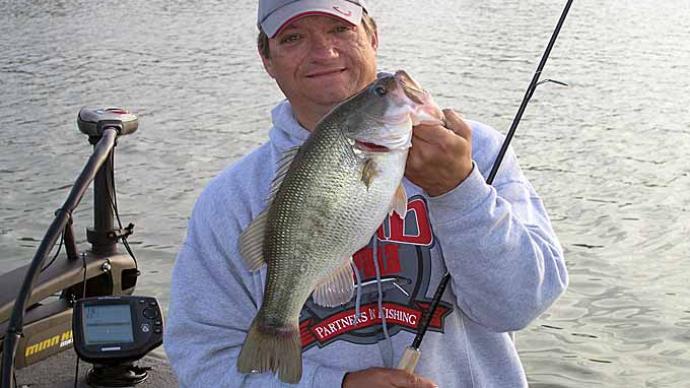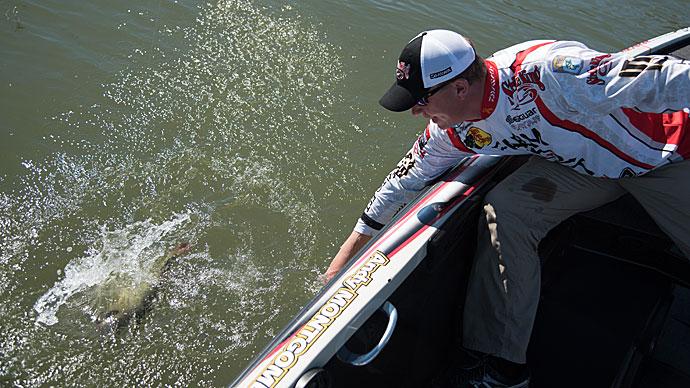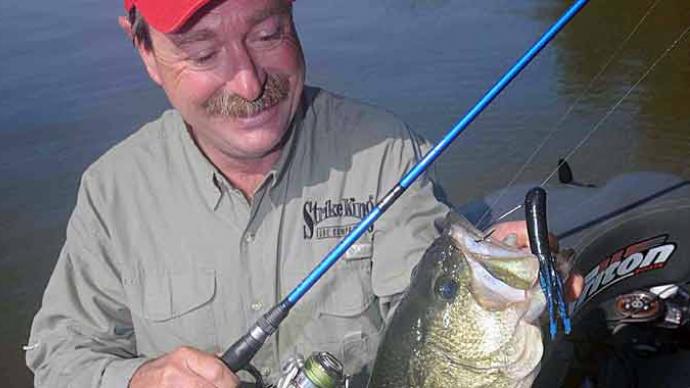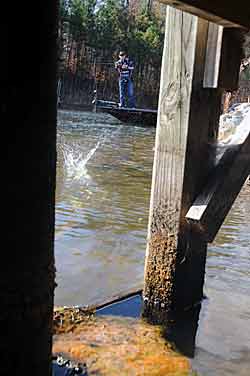
The dark spot covered with cobwebs in the back of that wooden pier looks like the ideal hiding place for a big bass.
However, the target is unreachable with a conventional overhand cast, and those wooden posts next to the spot make it dicey to skip your lure on spinning gear with light line. So to get to that spot, you will have to resort to skipping a power bait with a baitcast reel.
If you were good at skipping rocks across the water as a kid, you could become proficient at skipping with a baitcaster to those tight spots under floating docks, wooden piers, bushes, and cypress tree limbs. Bassmaster Elite Series pro Russ Lane compares the motion of skipping a baitcaster to the same underhand movement employed by a submarine pitcher in baseball.
The Alabama pro and former minor league pitcher uses another baseball analogy to describe anglers' biggest mistake when trying to skip with a baitcast reel. He notes anglers try to cast too hard when skipping, almost like when a hitter tries to “knock it out of the park” but swings too hard and misses. “That tends to force the bait down, and it doesn’t go on a flat enough trajectory (to skip),” says Lane. “You will have better results if you just have a long sweeping fluid motion.”
A Buckeye Lures Mop Jig tipped with a bulky Big Bite Baits YoDaddy is Lane’s favorite lure combo for baitcast skipping. “The Yo Daddy has small pincers on it, but the body is really bulky, and combined with that Buckeye jig and its flat head makes it a real good bait to skip.” He also likes to skip various Spro Frogs and a buzz bait tipped with a Big Bite Baits Jerk Minnow, a bulky soft plastic bait that acts as a plane to keep the buzzer gliding on the surface.
Finding the right size rod to skip a lure depends on your height. “I know some guys like a 6' 9" rod, but I am a little taller (6' 3"), so I like a 7' 6" lighter action flipping stick to skip that way,” says Lane.
Most of the time, Lane skips with a baitcaster filled with 50-pound Sunline FX2 Braid. “One thing that helps with the buzz bait is to skip it with braided line,” he says. “Braided line skips ten times easier than fluorocarbon or monofilament.”
Beginners can learn to skip with a baitcaster on dry land with a five-gallon bucket and a lead weight or old jig tied on their line. Lane recommends standing on the bucket and practice skipping the weight or jig across a flat concrete surface. “You can tell if you are doing it right,” Lane says, “it will skip a long way. If you are not, it will hit the concrete pretty hard and only bounce twice.”
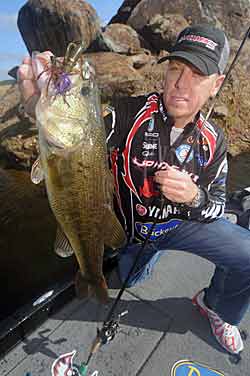
Lane usually turns off all the brakes on his reels and applies thumb pressure to control the speed of his spool while baitcast skipping. He suggests beginners should start with two brakes on their reels until they become proficient at skipping. Then they should graduate to one brake and eventually turn off all the brakes to start getting more distance on their skips.
The first step in baitcast skipping is to let out the right amount of line from the rod tip. “I will reel the line closer to the rod tip than on a normal cast-- maybe 6 inches for the most part,” Lane says.
As he goes through the throwing motion, Lane makes sure he keeps his rod tip within about 2 feet of the water. “Obviously, the closer you can get your rod tip to the water, the flatter your trajectory can be,” he says.
Before his rod tip rises on the follow-through, Lane releases his thumb from the spool to send the lure on its way. Lane applies thumb pressure on the spool when the lure hits the water. “For the most part, my thumb is staying on the spool the whole time (of the skip),” he says. “I am just getting a good feel for how much pressure to apply. The main thing is to let it go at the right angle at the right time, and as soon as it hits the water, start applying a little pressure. Then about the time, you think it’s going to stop skipping, just stop the bait, and you won’t have any backlash.”
Another technique Lane employs for shorter range skipping is the pitch skip. This tactic allows Lane to skip his lure deep into low-hanging cover that is unreachable with a conventional pitch.
Using a 7-foot rod, Lane estimates he starts pitch skipping with about 6 1/2 feet of line. “I let enough line out to where the bait is about even with the back of my reel,” says Lane.
The B.A.S.S. pro lowers his rod tip and waves his rod in a sidearm fashion similar to a backhand tennis swing rather than sending it straight upwards in the standard pitching motion. “You still want to use a low sweeping trajectory,” he says. The release point is the same as the skip cast (when the rod tip starts to elevate), and Lane applies thumb pressure to the spool as soon as the lure touches the water.
Learning how to skip with a baitcaster gives you the best chance to trigger a strike from a big bass lurking in the dark spot covered with cobwebs in the back of that wooden pier and to winch it out of its hiding place without breaking your line.
BassResource may receive a portion of revenues if you make a purchase using a link above.


